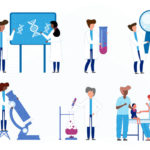Rethinking the origins of cerebral palsy

Cerebral palsy (CP) has widely been viewed as the result of perinatal oxygen deprivation or other birth-related factors like prematurity. For many children, this is true. But new work from Boston Children’s finds that up to 1 in 4 have an underlying genetic condition with the potential to change the approach to their care. Findings appear in the Annals of Clinical and Translational Neurology.
“In CP, the first thing that comes to many physicians’ minds is birth injury or asphyxia,” says senior investigator Siddharth Srivastava, MD, a neurologist in Boston Children’s Cerebral Palsy and Spasticity Center who specializes in neurogenetic disorders. “That idea has become pervasive, in both neurology and orthopedics training and among the general public.”
The idea that birth factors are the cause of CP has led some families to feel at fault. Parents often wonder if something that happened during pregnancy caused their child’s condition.
“One mother of an adult with CP told us that his genetic diagnosis absolved her of more than three decades of guilt,” says Srivastava. “Many families felt they finally had a sense of closure.”
Genetic findings in cerebral palsy
Through the Children’s Rare Disease Cohorts (CRDC) genomics initiative, the research team sequenced the DNA of 50 patients with CP. Their average age was 10 years.
All patients had clinical exams and brain MRIs. They fell into three groups:
- 20 had a known risk factor for CP, such as prematurity, a brain bleed, or perinatal asphyxia or hypoxia.
- 24 had no known CP risk factors.
- Five were “CP masqueraders” — meeting most of the criteria for CP but whose condition was deteriorating. (By definition, CP is a non-progressing disease.)
“We wanted to reflect the breadth of patients we see,” explains Srivastava.
Overall, sequencing identified causative or likely causative genetic variants in 13 patients (26 percent). Sequencing’s highest yield was in the CP masqueraders (those with progressing CP-like disease), flagging mutations in three of five patients (60 percent). Next were patients with CP and no known risk factors: Seven of 24 (29 percent) had a genetic cause.
Surprisingly, sequencing also identified mutations in three of 20 patients (15 percent) with established CP risk factors. One had a rare genetic disorder that predisposes to early stroke, and two had genetic conditions not previously associated with CP.
“These three patients are particularly intriguing,” says study co-leader Maya Chopra, MBBS, FRACP, a clinical geneticist and director of Translational Genomic Medicine at the Rosamund Stone Zander Translational Neuroscience Center. “Could genetic disorders have made them more vulnerable to early brain injury? We have much to learn about the interplay between rare gene variants and perinatal events in the development of CP.”
Implications of a genetic diagnosis in CP
In some cases, the genetic findings led to changes in the patient’s care plan. One had a mutation in a gene linked to a metabolic disorder and was referred to the metabolism clinic. Another was referred for ocular and kidney evaluations based on his mutation. A third had a mutation linked to a progressive neurological disorder. This alerted his care team to watch for worsening of his condition.
Based on their findings, the researchers recommend the following:
- Consider a genetic cause for any child who has CP without known risk factors, or has CP-like features but whose condition is worsening, and refer accordingly.
- Consider genetic testing in children with known risk factors for CP if they have clinical features suggestive of a genetic condition, such as congenital anomalies or other affected family members.
- Reevaluate children with CP periodically to ensure other aspects of their condition haven’t been missed, or to see if new features have emerged over time.
From precision diagnosis to precision treatments
Benjamin Shore, MD, MPH, co-director of the Cerebral Palsy and Spasticity Center, is excited by the implications of the study, the first of its kind.
“Historically, clinicians have assigned the diagnosis of CP to many children who have elements of muscle tightness and developmental delay without really understanding the cause,” he says. “We can now investigate these causes with much more detail. I hope in the future we can provide genetic diagnoses for many more children, particularly CP masqueraders. This research is just the tip of the iceberg.”
We have much to learn about the interplay between rare gene variants and perinatal events in the development of CP.”
Annapurna Poduri, MD, MPH, co-senior author on the paper, directs the Epilepsy Genetics Program and the CRDC’s Epilepsy Cohort Study at Boston Children’s, and sees a parallel with epilepsy. The program has identified dozens of genetic causes for epilepsy, some of which are treatable.
“We now have the scientific knowledge to pursue a precise diagnosis for children with CP that is not just descriptive, but that provides answers and may open a door to treating some of the underlying conditions we uncover,” Poduri says. “With precision diagnosis will come precision treatments for more and more children with CP, epilepsy, and other neurodevelopmental disorders.”
Refer a patient to the Cerebral Palsy and Spasticity Center.
Related Posts :
-

Diving deep on epilepsy genetics
When child neurologist Annapurna Poduri, MD, MPH finished her clinical epilepsy fellowship at Boston Children’s Hospital in 2004, she was ...
-

It takes a village: Creating best practices for personalized treatments
In 2019, doctors and scientists at Boston Children’s Hospital announced a medical landmark. In the space of one year, a ...
-

What it’s like to have SDR surgery: Scarlet’s story
Scarlet is 9 years old. When she was 7, she underwent selective dorsal rhizotomy (SDR), a procedure in which a surgeon cuts ...
-

New genetic test yields answer after family’s 10-year search
Kate Cole knew her daughter Lilly was different almost from the moment of birth. She was “a floppy baby,” lacking ...





